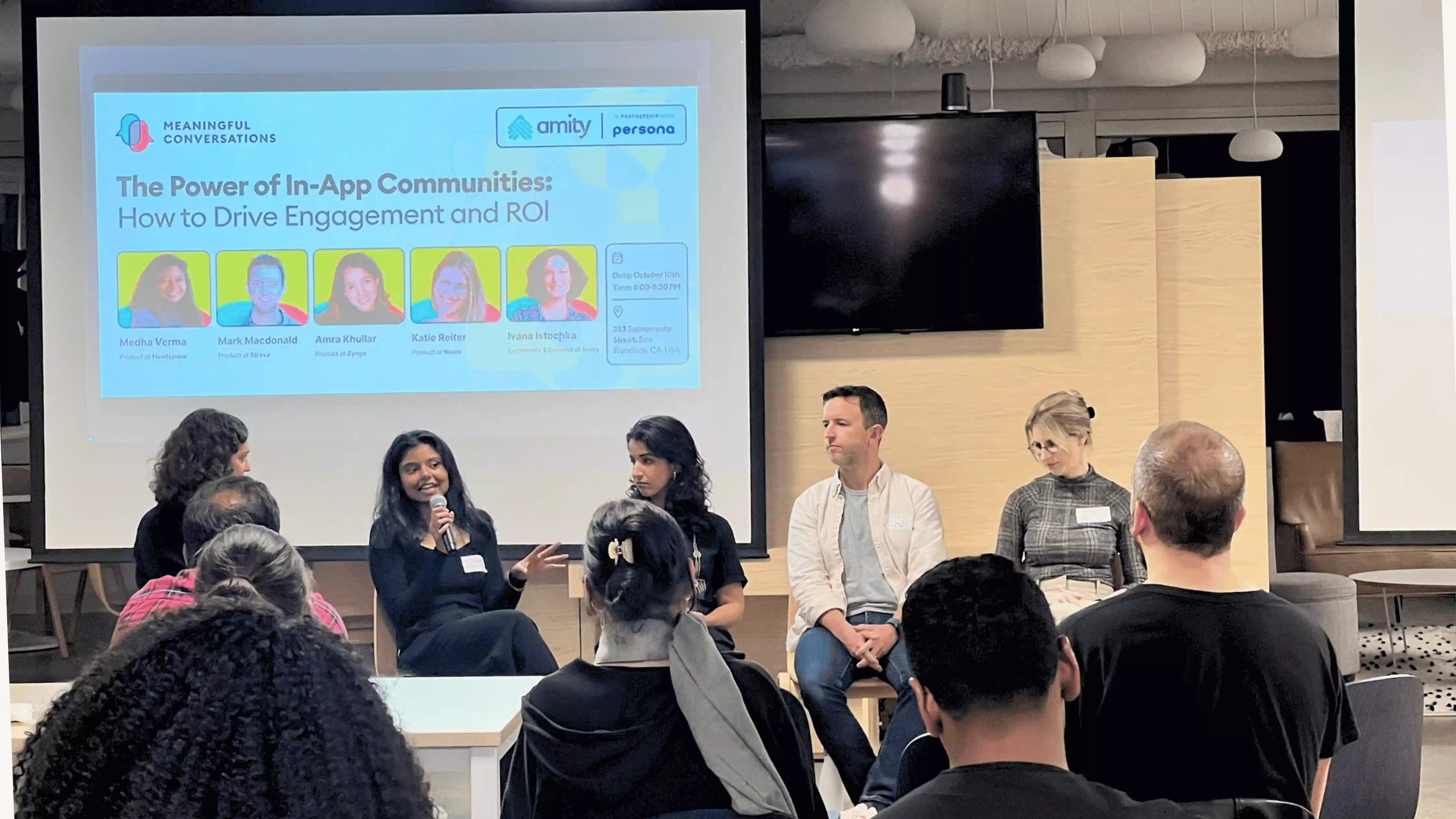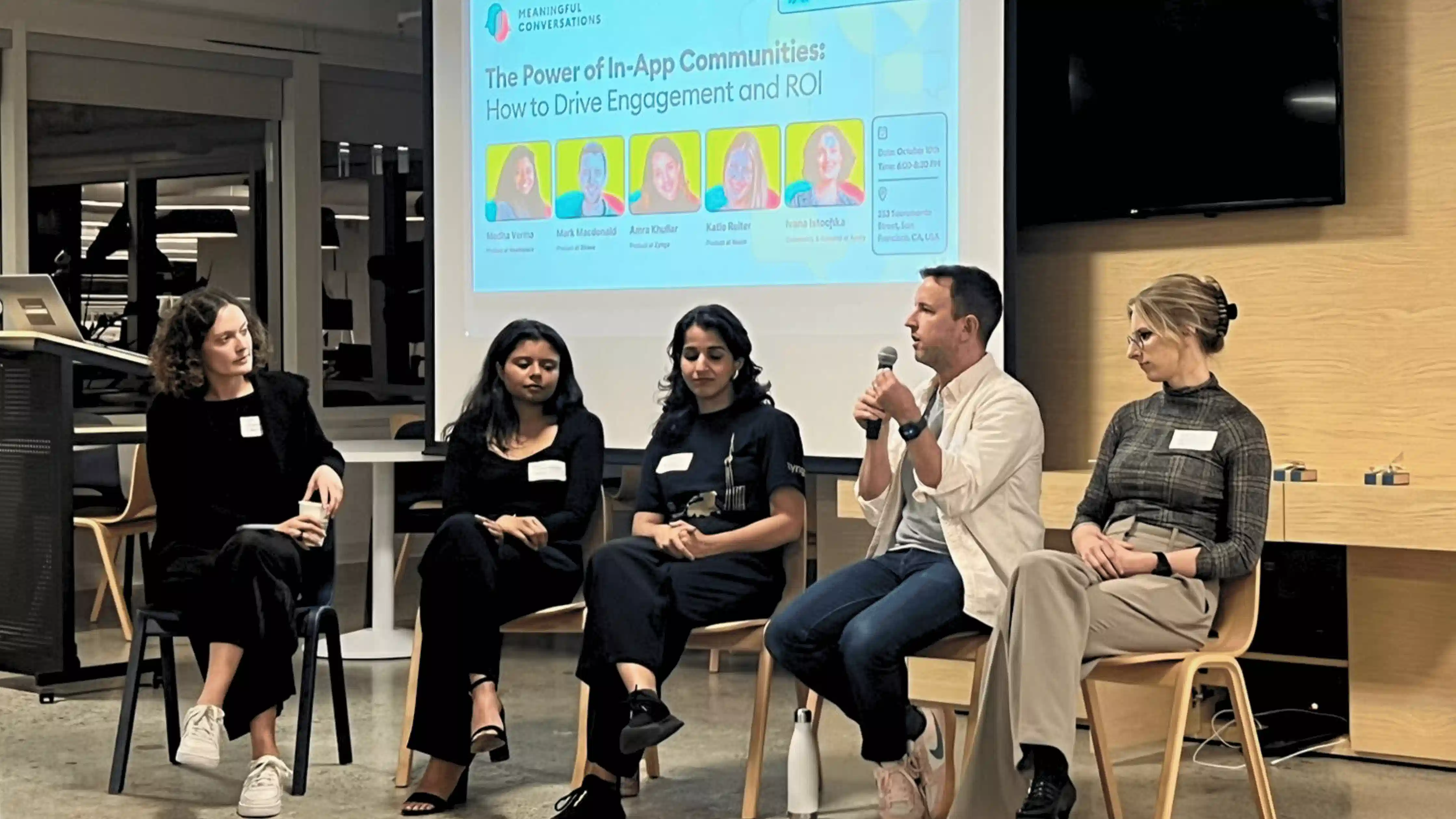Communities are at the heart of so many successful apps these days. Our panel of (amazing) speakers shared their secrets to app growth through community success.
We launched our Meaningful Conversations Meetups last year to go beyond networking, bring together some pretty incredible people, talk about the things that matter, and actually make a difference in the world.
Which brings us to the first event in San Francisco we hosted in October 2023 to talk about "The Power of In-App Communities: How to Drive Engagement and ROI".
And even now, seeing our fantastic panel of speakers brings us so much pride and joy:
Medha Verma, Product at Headspace, a well-known meditation and mindfulness app. Medha shed light on how they've successfully integrated community features to enhance user engagement, creating a more enriching experience for their users.
Mark Macdonald, Product at Strava, a popular fitness tracking app. Mark shared how Strava's in-app community has helped motivate athletes, foster connections, and boost retention.
Amra Khullar, Product at Zynga, a leader in mobile gaming. Amra discussed Zynga's approach to in-app communities and how they've harnessed the potential of these communities to enhance player engagement.
Katie Reiter, Product at Noom, a science-based diet and exercise platform. Katie shared insights into how Noom has used community features to inspire users, provide emotional support, and drive positive behavior change.

Meaningful conversations on in-app communities
In-app communities have countless benefits: they "elevate user engagement, serve as a dynamic customer support channel, become a valuable source of user-generated feedback, foster unwavering brand loyalty, and even facilitate collaborative product and content creation."
Without further ado, let's take a look at how Headspace, Strava, Zynga, and Noom are achieving app success by focusing on their communities, with real-life experiences, strategies, and insights from our speakers.
Medha from Headspace: prioritizing genuine social support
Medha works at Headspace, a platform initially founded through in-person meditation events across London and the UK by Andy and Rich. These events evolved into a community that eventually led to the creation of the Headspace app. She emphasizes that community is at the core of mental health and is a valuable support system. The idea is that people can learn from and support each other in their mental health journeys. Headspace aims to create spaces where individuals feel a sense of belonging and shared identity, making them more accountable and motivated to tackle their challenges.
"The way we think about community is a support system. It's not 'how much do I get people to engage in our content' or 'how much do I get people to open our app'. It's really about 'how do we create spaces where people can meaningfully support each other?'."
The primary focus for Headspace is to provide meaningful support through its community, both on and off the app, rather than emphasizing content engagement or app usage. A major challenge is finding a balance between offering social support without turning the app into a social media platform. They strive to avoid addictive elements and social validation loops while ensuring that users feel supported. An example is the introduction of community thoughts under course content, allowing members to chat about their experiences without excessive notifications. Headspace carefully evaluates decisions that could lead to addictive behaviors and prioritizes providing genuine social support.
Discussion spaces in Headspace are thoughtfully designed, and they draw from two attachment theories: identity-based and bond-based attachments. Identity-based attachments focus on shared identities, while bond-based attachments emphasize member-to-member connections. Headspace predominantly builds identity-based attachments to keep discussions centered on specific topics, such as course engagement. They also take steps to ensure safety by moderating content and identifying and escalating potentially harmful comments to care teams. This approach aims to create spaces where members feel supported and receive valuable content.
Amra from Zynga: tailoring social experiences
Amra, a product manager at Zynga, discusses how Zynga's vision is to connect the world through games, particularly through titles like Farmville and Zynga Poker. She emphasizes the evolution of social connectivity within games, moving from virality through social media to fostering communities and driving engagement through various social features, such as competition, leaderboards, and team-based activities. She underscores the importance of understanding the diverse player motivations across different games and aligning social features accordingly. For instance, some games are highly competitive, while others offer more delightful experiences. The key is to tailor the social connections to the player's preferences and motivations.
"There's been so much of an evolution in how you connect people through games. And a lot of times now, for the most part, it is through fostering communities within the app. But then a whole other way is really through driving engagement, through a lot of social features…"
Amra acknowledges the challenge of onboarding new players effectively, given the short attention spans and the abundance of competing games in the market. She emphasizes the need to engage players early and establish healthy relationships through matchmaking with machine learning. Balancing the introduction of new players with experienced ones is crucial. The goal is to create a valuable experience for all players and foster the core loop of the game.
Regarding player referrals, Zynga tracks metrics related to referrals and rewards players for milestones like playing a certain number of words with referred friends. They use referrals as a way to grow their user base and reactivate existing connections who may have lapsed. The success of various social features depends on how many players engage in activities like joining a club or sending lives, as these aspects contribute to player retention and monetization, which are fundamental for business growth.

Mark from Strava: tailoring social experiences
Mark, the product lead for community growth at Strava, explained how Strava initially gained recognition for its competitive features but has evolved to prioritize community as a powerful motivator for athletes to support each other, achieve fitness goals, and have fun. Mark highlights Strava's growth through word of mouth and its ability to tap into existing real-life communities, explaining how Strava served as a connection tool during the pandemic when people worldwide were restricted, and Strava became a platform for diverse affinity groups and micro-communities. These groups provide motivation and support outside traditional communities, including a Strava art community focused on sharing GPS-drawn images.
"You can't just plug in community and expect it to offer it. You have to introduce people to the core values first for it to really be valuable."
Mark emphasizes that the community experience doesn't begin at full throttle for new users but rather evolves from a foundational engagement with core activities like uploading GPS tracks. Encouraging users to take part in these fundamental activities first is essential before introducing them to the broader community. This approach aims to strike a balance, avoiding overwhelming new users while gradually acquainting them with the platform's social aspects.
He also addresses the concept of the "empty feed problem" when new users start with no connections. The platform highlights specific members of the community who represent core values and achievements. While these profiles can be inspiring, Strava is cautious not to overwhelm new users with intimidating or overly ambitious content. Instead, they aim to promote positive and attainable examples.
Mark mentions Strava's focus on retention, discussing the core engagement loop of participation, celebration, and motivation. Participation involves users going for a jog, workout, or other physical activities. Celebration encompasses feedback from the community, such as comments and likes, which motivate users for their next activity, whether it's exploring new routes, participating in challenges, or setting fitness goals.
Katie from Noom: inspiration through community
Katie from Noom discusses the company's goal of helping people lead healthier lives through behavior change, initially focusing on tackling obesity. The integration of a community feature within the app aims to offer users a sense of normalization and inspiration on their health journeys. The pairing of these social aspects with coaching supports behavior change. The community serves to inspire users by showcasing positive accomplishments, while normalization helps users realize that they are not alone in their struggles. This combination builds belief and self-efficacy, fostering behavior change.
"And we see community as a great way to drive a lot of behavior change principles that are really powerful for those users, specifically things like normalization to help these individuals know that they're not alone."
Katie also addresses the challenges of social media, where users desire less screen time, more real-life presence, and accurate health information. Noom employs behavior coaches to manage community spaces, post content, comment on members' posts, and link users to relevant discussions. Customizations within the app ensure that coach posts are visible and promote a positive, accurate, and health-focused environment.
Key metrics for assessing the community feature's value include retention within the community, qualitative user research to gauge the feature's importance, and tracking the impact of the community on customer acquisition cost. Noom aims to use the community to drive virality and bring more people into the app.
What we learned: 6 key takeaways
Our event provided a platform for these incredible industry leaders to discuss the transformative impact of in-app communities. Now that you've read what they each had to say, let's take a look at the main concepts we learned from our conversation that all of our speakers shared:
1. Building stronger connections: In-app communities offer users a space to connect, share experiences, and support each other. These connections go a long way in keeping users engaged and committed to the app.
2. Encouraging user-generated content: Community-driven content, such as user-generated reviews, recommendations, and discussions, can significantly enhance the overall user experience and build trust.
3. Fostering loyalty: When users feel like part of a community, they are more likely to remain loyal to the app. This loyalty translates into higher retention rates and increased ROI.
4. Personalized experiences: Tailoring content and interactions based on user preferences and behaviors can be a powerful engagement strategy, and in-app communities provide the ideal platform to achieve this.
5. Emotional support: In-app communities are not just about sharing tips and information; they also serve as a source of emotional support. Users facing similar challenges can find solace and encouragement within the community.
6. Driving positive behavioral change: Communities can be instrumental in motivating users to make positive changes in their lives, whether it's adopting a fitness routine, meditating, or maintaining a healthy diet.
In-app communities: a gateway to success
Our Meaningful Conversations Meetup highlighted the immense potential of in-app communities in enhancing user engagement and ROI. By creating spaces where users can connect, share, and support each other, companies like Headspace, Strava, Zynga, and Noom are pioneering a new era of app success.
The key takeaway is clear: embracing the power of in-app communities is a strategic move that can set your app on the path to remarkable growth and user satisfaction.


